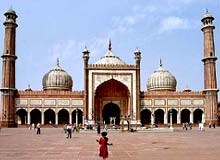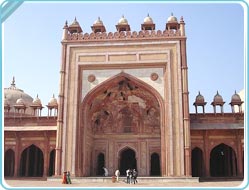While Islam spread through India, many mosques have been built for its propagation.Through the passing of time, these centers of worship have become well known and popular tourist destinations, owing to the architectural grandeur and spirituality associated with them. Historically, speaking about the mosques in India, the Cheraman Juma Masjid located at Methala village, in Kerala is considered to be the first Indian mosque which was builtaround 629 AD. This small but beautiful looking mosque depicts a mix of Arabian and Keralite artistry in its construction. A traditional pond still exists today in testimony of the religious fervor it used to contain. Cheraman Juma Masjid  Location : 1500 m from Kodungallur Centre, Location : 1500 m from Kodungallur Centre,
Kerala
Significance : First Juma Mosque in India
Named After : King Cheraman Perumal
Situated in : Methala Village This Mosque is located at Kodungallur, about 37-km from Thrissur.
This Mosque resembles temple. Built in 628 AD, in Al Hijra 7, that is, 7 years after Prophet's migration to Madina, it is the oldest Mosque in India and the second oldest in the world.
The legend has it that King Cheraman Perumal converted into Islam and accepted the name of Thajudeen. It was after the conversion he married the sister of Jeddah King of Saudi Arabia. Before his death Thajudeen had handed over letters addressed to various Kings in Kerala, requesting help to propagate Islam, to his brother-in-law. The history has to say that the King of Jeddah came to Kerala and sought help of the King of Kodungallur to build a Mosque. The Kodungallur King offered all help and the Juma Masjid named after Cheraman came up.
The Legend
It is locally supposed that King Cheraman Perumal went to Mecca , embraced Islam and accepted the name Thajuddin. He married the sister of the then King of Jeddah and settled down there. Before his death he handed over to the King of Jeddah numerous letters addressed to some rulers of Kerala seeking their help to propagatethe tenets of Islam in Kerala. After his death the king came to Kerala and met the Rajah of Kodungalloor who helped him to convert the Arathali temple into a Juma Masjid. and accepted the name Thajuddin. He married the sister of the then King of Jeddah and settled down there. Before his death he handed over to the King of Jeddah numerous letters addressed to some rulers of Kerala seeking their help to propagatethe tenets of Islam in Kerala. After his death the king came to Kerala and met the Rajah of Kodungalloor who helped him to convert the Arathali temple into a Juma Masjid.
Women are not permitted into the mosque at any time. Male visitors are permissible in with the prior permission of the cleric of the mosque. The festivals of Ramadan and Bakrid are celebrated with a lot of fervour in this mosque
The biggest and most famous of the historical mosques in India, Jamma Masjid at Delhi is most renowned for its size; it is the largest mosque in India. Nearly 20000 people reportedly visit it everyday. Built by Emperor Shah Jahan this sandstone and white marble monument is constructed on a highest platform so that its beautiful facade is visible to all across a great distance. Jama Masjid Jama Masjid of Delhi is the largest mosque in India. The Jama Masjid stands across the road in front of the Red Fort. Built between 1644 and 1658, Jama Masjid is one of the last architectural works of the Mughal emperor Shah Jahan. The spacious courtyard of the Jama Masjid holds thousands of faithful. Jama Masjid is located on a mound in the heart of the old city and projects beautifully into the Old-Delhi skyline. Jama Masjid Mosque was built in red sandstone and marble by more than 5000 artisans. Originally called the Masjid-i-Jahan-Numa, or "mosque commanding view of the world", the Jama Masjid stands at the center of the erstwhile capital city of the Mughals, Shahjahanbad. The Jama Masjid was completed under the supervision of Saadullah Khan, the Prime Minister of Shah Jahan. A sum of Rs 10 lakhs was spent on the construction of the Jama Masjid. The Jama Masjid is built on a red sandstone porch, about 30 feet (10 m) from the level of the ground and is about 1400 square yards (1200 m²) in extent. The Jama Masjid has three gateways, four towers and two minarets. The gateways in the north and south are led by a fleet of steps. The main entrance is on the eastern side facing the red fort. It was probably used by the emperors. The tower of the Jama Masjid is made up of five distinctive storeys. Each one of the storeys has a projecting balcony. The adjoining edifices are beautifully done with calligraphy.
The first three storeys of the Jama Masjid tower are made of red sandstone and the fourth one is made of marble, while the fifth is made of sandstone. The Jama Masjid is covered with intricate carvings and has verses inscribed from the holy Koran. The grand Red fort (Lal Qila) stands on the eastern side of the Jama Masjid. The main prayer hall of the Jama Masjid is made up of high cusped arches and marble domes. The cabinet in the north gate of the Jama Masjid contains a collection of Muhammad's relics - the Koran written on deerskin, a red beard-hair of the prophet, his sandals and his footprints, implanted in a marble block.
Rated among the historically famous mosques in India, is the Fatehpur Sikri Mosque at Agra. It today stands in grandeur of the bygone era and reflect true form of Persian an Hindu architecture; though some even attribute it to the famous Mecca, owing to the striking resemblance to it.
Jami Masjid Fatehpur Sikri Jami Masjid or the Friday Mosque is one of the most beautiful and largest mosques of the world. This elegant building is the most sacred building and the principal mosque of the town and thus situated on the highest point of the ridge where Fatehpur Sikri is situated. In fact, the Buland Darwaja commemorating the victory of Akbar over Deccan and the Tomb of the famous Sufi saint Sheikh Salim Chishti are a part of this spacious mosque complex. Built in the supervision of the saint himself and his descendants, it was completed in 1571. The vast quadrangle has the mosque on the western side and arcuate cloisters with broad slanting chhajja and splendid brackets crowned by series of square chhatris on the other three sides along with Buland Darwaja on the south, Badshahi Darwaja on the east and the tombs of Sheikh Salim and Islam Khan and the ablution tank in the inner courtyard. The main rectangular mosque consists of a central nave with a single dome, two colonnaded halls on its either side with two square chambers crowned with dome. The elegant and beautifully carved mihrabs adorn the main chamber and the two smaller rooms.
 The mosque marks the phase of transition in Islamic art as the indigenous architectural elements were blended with the Persian architecture. The pillared dalan of the façade, the iwan with three arched openings also framed by panels and crowned by five chhatris and the central mihrab adorned with inlaid mosaic of stones that are bordered by glazed tiles and has golden inscriptions on royal blue background. The interiors of the iwan are adorned with watercolor paintings depicting stylized floral designs. Even the dado panels, spandrels of arch, squinches and soffits are also painted profusely. Unlike other monuments, where domes are supported on squinches, here elegant corbelled pendentives support the done.
The entrance to the mosque is through the famous 54 meter high 'Buland Darwaza', and located to the north of the mosque is the Shaikh Salim Chisti Dargah, which is said to posses the power to bless the childless with children. 
The trail for famous mosques in India leads us to the Ajmer Sharief, called the 'Mecca of South Asia'. Located at the center of the Ajmer town in Rajasthan, this famous Dargah holds the tomb of the famous Sufi saint Hazrat Khwaja Moinuddin Chisti. The holy shrine inside the Dargah is encased by pure gold railing, while its apex also is a complete gold structure, drawing huge crowds on Urs festival that begins on the 25th of Jamadi-ul-Akhir in the month of May. A daily ritual that is also famous at the Dargah, is the cooking of kheer in two huge cauldrons that were donated by the emperors Akbar and Jahangir, to feed the poor, and the devotees visiting the Dargah. | Ajmer Sharief |
| |  About 135 kilometers southwest of Jaipur is Ajmer, the most sacred of all Muslim places of pilgrimage in India. The revered Sufi saint, Khwaja Muin-ud-din Chisti, who came to Ajmer from Persia in 1192, died in 1236 and was buried here. His tomb, the Dargah is visited by thousands of devout Muslims every year. The shrine was erected by Humayun. The Dargah also has mosques which were built by rulers such as Shah Jahan, Jahangir and Akbar. About 135 kilometers southwest of Jaipur is Ajmer, the most sacred of all Muslim places of pilgrimage in India. The revered Sufi saint, Khwaja Muin-ud-din Chisti, who came to Ajmer from Persia in 1192, died in 1236 and was buried here. His tomb, the Dargah is visited by thousands of devout Muslims every year. The shrine was erected by Humayun. The Dargah also has mosques which were built by rulers such as Shah Jahan, Jahangir and Akbar.
Akbar used to make a pilgrimage to Ajmer every year from Agra.
 The entrance to the complex is from the The entrance to the complex is from the Dargah Bazaar which leads to the first courtyard. This courtyard has a mosque built by Akbar and two cauldrons known as degs in which donations are made. These donations are later divided among the poor. The saints's tomb is in the centre of the second court. It is enshrined in a domed marble chamber and is surrounded by silver railings. The tomb attracts hundreds of thousands of pilgrims every year on the anniversary of the saint's death, which falls in the seventh month of the lunar calendar. It is also the venue for the famous Urs festival. |
|
No comments:
Post a Comment